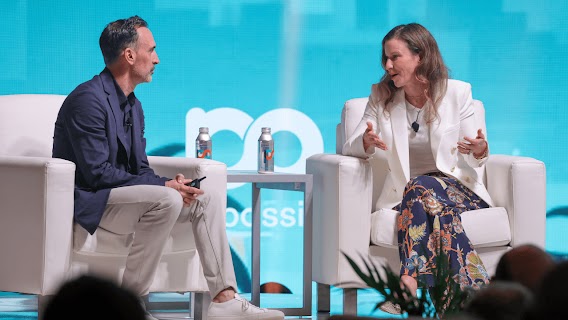Sean Downey, president, Americas & Global Partners, Google, spoke with Instacart CMO Laura Jones about her company’s approach to AI in advertising at Possible Miami. In the condensed conversation below, Jones shares how the company solves problems for consumers across the journey.

Every CMO wants to make their company a growth engine. Instacart CMO Laura Jones has done just that. Instacart has managed to rapidly grow its ad sales business and deliver unique consumer experiences by deploying AI-powered ad solutions and campaigns. I was delighted to speak with Laura about how Instacart combines first-party data with Google’s AI-powered solutions to achieve that growth. Our conversation has been edited for length and clarity.
Sean Downey: The big provocation for marketers using AI is: “What’s your strategy? What are you being tasked with by your CEO, and how have you thought about applying artificial intelligence to it?” What problems were you trying to tackle, and how did you leverage AI to do it?
Laura Jones: AI and ML have been a big part of our strategy from the very beginning. From a consumer standpoint, we’re using AI to make the product experience better, including smart recommendations and complementary items. For our advertisers, who play a big role in that question of — “What’s a great recommendation?” — we’re able to get more and more advanced when we start to think about what that looks like. And finally, for our retail partners, we are innovating with the Caper Cart, our AI-powered, smart shopping cart that brings all of this grocery intelligence to the aisles of the grocery store.
You’ve worked exceptionally hard to develop first-party data through your owned channels like your consumer app. But how did you think about collecting, organizing, and leveraging these audience insights in your marketing campaign to actually grow the business?
We have delivered over a billion orders. That means we have an incredibly rich data set on consumer behavior. Of course, we take privacy and data security seriously, so we aggregate and anonymize that data. But with that, we’re able to really understand purchase behavior. It helps us get smart about recommendations. We’ve also started to use that to power some natural language search. One of the fun generative AI use cases that we’ve delivered is the ability to ask natural language queries in the app. We call this Ask Instacart.
Instacart introduces its in-app AI tool “Ask Instacart” to help shoppers find exactly what they’re looking for.
So, as a consumer, I can ask, “What’s a good snack for a gluten-free five-year-old?” And the app can look at other people’s purchase behavior and get smart about the best way to answer this question. There’s real value-add for the consumer by showing up and simplifying their purchase journey. And, then, from an advertiser standpoint, there’s an incredible opportunity: Here’s someone who has intent, who’s looking for something to buy. You can show up and help that person discover your brand, convert right there in the app, and get that product into their hands quickly.
You’re touching on something that I think is really critical. Advertising has always been about the art of prediction, and predictive AI has been around for a long time. But having a solid foundation for more accurate predictions that drive growth is a key thing, so I love that you’re doing language modeling and using consumer language to build recommendations.
We have seen a lot of success with broad match, which essentially helps us do keyword prospecting. Of course, we do well on words like “grocery delivery” and certain kinds of product terms, but we’ve also found interesting keywords that we didn’t even know were converting for us. One was around detox diets. Here’s someone who wants to go on a juice cleanse, and they’re actually a perfect customer for us, but we might not have thought of that term on our own. So it applies on our own platform and when we’re using Google tools.
You’re searching for people who search for you.
Yes.
And that can be done off site. Now, when someone comes to work with you, who might not have as much data, you can develop a richer profile to help them build campaigns. You’ve been building an emerging retail media network, but not in the way most people think about retail media networks. How has that transitioned to working with marketers thinking differently about getting the right consumers on their page?
We’re taking what has been a retail media network and expanding it into the concept of retail-powered media.
For us, our bread and butter is really that weekly shop. We also capture a lot of impulse purchases. But because we have both — that big-basket weekly shop that’s recurring, that’s over a hundred dollars, plus all the impulse purchases — we have a really rich view of consumer behavior. So that first-party data, coupled with closed-loop measurement, provides a unique opportunity for our brand partners to come in and meet people in that moment of intent, when they’re already building that cart, and figure out how they want to show up for that customer.
Over the past few years, we’ve moved from lower funnel solutions, like classic sponsored products, all the way over to mid-funnel creative solutions, like shoppable video, to drive consideration even if someone might not be quite ready to convert. Then we have tools like coupons that might incentivize someone to move from consideration to purchase in the same journey. Off the back of that are really rich insights for the advertiser, which we’re now starting to move off platform.
I think that’s a great framework for other marketers: A solid data foundation based on smart tagging, smart collection principles, consented data. You have smart advertising campaigns set up for yourself, and you’ve leveraged tools to get the most out of them. Then you’ve done smart campaigns for advertisers on Instacart attached to your core data. Now, you’re moving into transformation. You’re getting into next-level audience inspiration, next-level creative delivery, because you can identify where somebody is in their purchase decision — AI Marketing 301. That wasn’t easy, so how did you start with that baseline to get where you are?
Because we’ve always had a rich catalog, with 40 billion variations between the items, the stores, and the locations, we’ve had to be data-centric from day one. It’s been a learning experience. Now, we’re taking what has been a retail media network and expanding it into the concept of retail-powered media. I think this is the next big innovation: Using this rich data in partnership with both CPG and platform partners. We take what we’ve learned from our own Google Shopping ads journey, making that available for our partners so we can buy Google Shopping ads to reach people new to category, new to brand, and then convert them.
We’ve highlighted this with Nestlé. They saw triple-digit growth in weekly clicks, and about half of those customers were new-to-brand. We’re now trying to open this up and be an accelerant to all of our partners’ campaigns, wherever they run media.
As you take away the things that can be delegated to the machine, you free up strategic brainpower to pursue those greater innovations.
So the marketing didn’t change, but the intelligence did. The insights did. Nestlé has always been great at running performance media, but in order to get to triple-digit improvements, you had to get the insights. I always look at AI as an amplification effect. That if you do this, you’ll get incremental growth, and then exponential growth. That’s how you start to create efficiencies that pay back. That’s the kind of provocation I want more marketers to have, because I think it will make their results better.
I agree. As you stack efficiency gain upon efficiency gain, all of those gains compound, and that is really an accelerant. We’ve seen that in our own journey and with our advertisers. Through Google tools and our homegrown tools, we’ve managed to get double-digit improvements in our efficiency on bidding. And again, to your point, is chasing efficiency enough? I think the answer is: As you take away the things that can be delegated to the machine, you free up strategic brainpower to pursue those greater innovations.
You talked about creative. Not robo-creative, but a very purposeful journey through a funnel where timing your message is important, and you’re learning and taking in new business units as you do it. How do you think about the delivery of the offer on top of this world?
There are certain use cases that, for me, are no-brainers. We’ve used AI to enrich product descriptions on all our product pages to make them better, more relevant, more personalized. We’ve used Google tools to do image scrubbing at scale for all these catalog items. No human wanted to do those things. It’s not fun for a human to go through images removing commercial text.
We’re thinking about how to automate tasks that are not rewarding and retain human ingenuity as the core engine.
As we have played around with AI, we’ve had some wins and misses. For example, we used AI-generated photography in some of our recipes, and it didn’t always work out! There were some funny-looking turkeys with three legs. Being at the bleeding edge means having some of those learning moments.
As we proceed into more complex creative, we’re thinking about how to automate tasks that are not rewarding and retain human ingenuity as the core engine. It’s about the key insight, the service and meaning you deliver to the consumer, and AI can be a partner in that. We’ve played around with some storyboarding tools and sometimes use generative AI in brainstorms. But that’s no substitute for the actual strategy or, frankly, the judgment and taste that go into great creative and storytelling.


